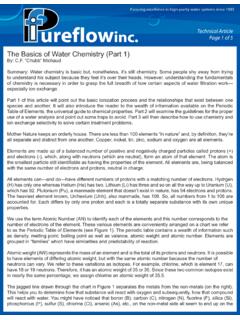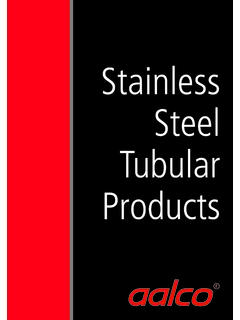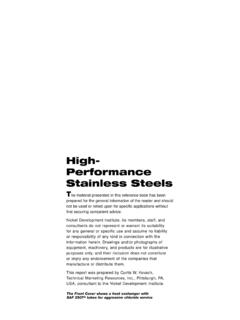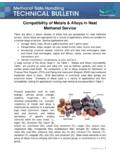Transcription of Why Passivate Stainless Steel and What Happens If You …
1 Why Passivate Stainless Steel and what Happens If You Don tBy: Patrick H. Banes, Astro Pak CorporationTo insure having the maximum corrosion resistance that austenitic Stainless Steel has to offer, the Stainless Steel surface must be in a passive state. The passive condition on the surface of the Stainless Steel is obtained by formation of a chromium oxide film on the metal s surface. This is accomplished by passivating the metal. Chemical passivation procedures using alkalines, wetting agents, chelants, and organic or inorganic acids are used to clean the metal surface thoroughly and in conjunction with an oxygen rich atmosphere, a uniform chromium oxide film forms.
2 The key is to have a uniform chromium oxide film with an acceptable chrome to iron ratio (typically>1) and thickness (20-50) angstroms. Passivation is required to restore or enhance the chromium oxide film on the Stainless Steel surface when it has been manipulated by surface finishing, welding, grinding, external contamination, etc. Mechanical finishing of Stainless Steel surfaces allows for a very smooth surface and is a prerequisite for sub-sequent electro-polishing. The mechanical action disrupts the existing passive surface and results in a surface with a low chrome to iron ratio.
3 The possibility of surface contamination getting pushed or smeared into the metal surface or sub-surface also Stainless Steel is one of the primary reasons for passivating. The metal surface is altered and free iron is released from the alloy. The chrome to iron ratio is also lowered in the heat affected zone of the weld. The free iron on the metal surface can initiate corrosion and/or rouging. It should be made clear that a suc-cessful passivation operation depends on having a proper weld. Passivation cannot make problems associ-ated with lack of a suitable welding purge go away, severe weld discoloration or sugared , grinding and mechanical polishing also alters the Stainless Steel surface and can affect the passive surface.
4 It is very important to use tools dedicated for use with Stainless Steel when performing these opera-tions. Use of non-dedicated tools can result in leaving contaminants such as iron on the metal surface or even worse embedding contaminants into the Stainless Steel . Stainless Steel surfaces with embedded iron can be passivated and pass criteria such as a ferroxyl test, only to exhibit a bloom of rust after being cleaned-in-place, steam sterilized or put into service. Performing multiple passivation procedures or refinishing the affected area may be required to alleviate the problem of the embedded a system is being fabricated there is the possibility and a likelihood that residues from the fabrication process end up in the system.
5 Small particles, shavings of Stainless Steel , are not in a passive state and tend to have a high free iron content. Extreme care must be taken to prevent the Stainless Steel particles from get-ting into the system during construction. Evidence of particles in a system can be found embedded in valve diaphragms, inside spray balls and at valved low points. Corrective action to remove particulates needs to be taken during subsequent flushing and or passivation procedures by using filtration. When a high purity water system is modified, the issues previously discussed: welding, cutting, grinding and polishing come into play and are reason to Passivate .
6 There is another situation that arises when an existing system is being modified. New tubing is being joined to existing tubing. what is the condition of the existing tubing? Is it rouged? New tubing requiring preoperational passivation may in fact be welded to tubing that is rouged. Typical preoperational passivation procedures will not remove rouging, thus the passivating chemi-cals never touch the Stainless Steel surface. Thought has to be put into the possibility of this situation and the Technical ArticlePage 1 of 4options that are available.
7 Do I derouge the existing system prior to welding new tube to the existing tubing? Do I install ferruled connections, passivating the new tube, swab Passivate the new ferrules on the existing tube and clamp the new and old tube together? Do I weld the new tube to the existing and derouge and pas-sivate the combined new and existing system? When a system is being modified, it is an excellent opportunity to deal with existing conditions such as system rouging. The system is down, the passivating contractor is on site, chemicals are going to be put into part if not all of the system, so why not derouge and Passivate the entire system while the opportunity presents contamination from an external source introducing iron, chlorides and other unwanted contaminants, would be another reason to chemically clean and Passivate a system.
8 The issues associated with free iron contamination have already been discussed. Chlorine contamination can be a serious problem. The pres-ence of chlorides on Stainless Steel surfaces is profound. Chlorides can penetrate the chromium oxide film and pit the base metal. This type of corrosion leads to system rouging and ultimately metal failure. In my many years of being involved with passivating systems for the pharmaceutical industry, I have seen multiple cases where metal failure is directly related to chloride contamination. Few if any failures could be linked solely to iron contamination.
9 austenitic Stainless steels used in the pharmaceutical industry have a very low tolerance to chloride attack and should be avoided at all costs. In the proposed multiple step reaction the presence of chlorine causes the dissolution of the chromium oxide film, formation of ferric iron oxide and hypochlorous The significance of the formation of the hypochlorous acid is that it oxidizes free iron and releases more chlorides, thus self-perpetuating the can also be passivated on a regular basis as a form of preventative maintenance. Regular passiv-ation can nip future problems in the bud while maintaining the system in a pristine passivated condition.
10 The reality of being able to Passivate a system on a regular basis is not that simple. Lost production time, sched-uling issues and the costs associated with system passivation often prevent scheduled maintenance passiv-ation of systems from being performed. The alternative is to clean and Passivate a system when it is deemed necessary. System inspection can be a useful tool in helping to make that decision. One of the best ways to determine what is going on inside a water system is to take a look. Is rouging occur-ring is the system? Is the rouge very light or well established?







